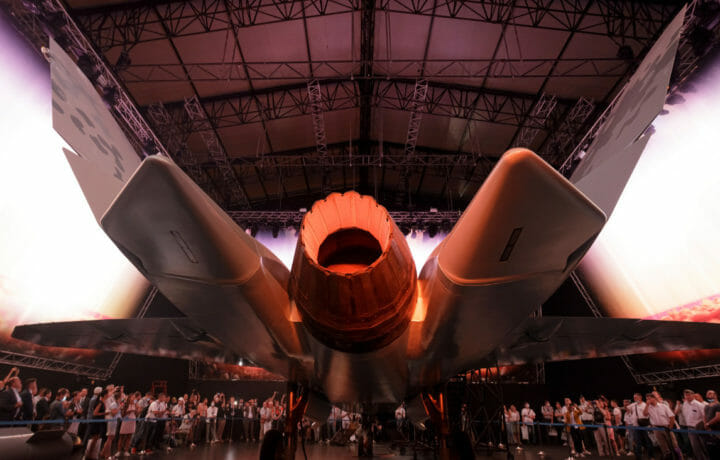Earlier this month, the state-owned Russian defense conglomerate Rostec showed off its recently unveiled Su-75 “Checkmate” aircraft at the Dubai Airshow 2021. It was among several aircraft that the Russian firm brought to the show to entice international buyers, notably those from the Middle East, Africa and Latin America. The single-engine light tactical fighter has been widely touted to be a more affordable option to the American-built Lockheed Martin F-35 Lightning II, which is currently operated by 14 nations around the world.
It is clear that Russia, which is the world’s second largest arms exporter after the United States, doesn’t want to be squeezed out of the combat aviation sector. To that end, Rostec also presented its Sukhoi Su-57, the country’s first fifth-generation fighter, to foreign buyers.
“First of all, I want to mention the Su-57. This is the world’s sole ‘heavy’ fifth-generation fighter offered for exports,” Rostec chief Sergei Chemezov told Tass in a run-up to the international aviation exhibition. “It features completely different combat capabilities: stealth, a high speed, a combat payload and maneuverability and hence the respective interest for it.”
The Dubai Airshow marks the first time the Checkmate has been displayed outside of Russia. While it is still in the prototype stage and hasn’t actually taken to the skies, the first flying model is reportedly already under construction at the United Aircraft Corporation’s KnAAPO facility in the manufacturing plant at Komsomolsk-on-Amur. That is the same facility that builds the Sukhoi Flanker as well as the Su-57.
Russia is working in overdrive to get the Su-75 aircraft to market, in part because it has been reported to be a serious contender to the F-35. It offers many of the capabilities of other fifth-generation aircraft, including stealth, but is only powered by a single jet engine. That could make it attractive to countries without the deep pockets to acquire the pricey F-35.
Eyeing the Middle Eastern Market
In less than 20 years, the Dubai Air Show – held at the Al Maktoum International Airport at Dubai World Central – has grown in size and stature. This events show reportedly attracted some 1,200 exhibitors from 148 countries around the world.
Russia used it as an opportunity to show off its offerings, and a high-level delegation even met with Abu Dhabi’s powerful crown prince, Sheikh Mohammed bin Zayed Al Nahyan. No doubt it was about convincing the United Arab Emirates to take a look at the Checkmate over the F-35.
It was over a year ago, when the White House agreed to sell the F-35 to the UAE after the Gulf state formally established ties with Israel. The $23 billion sale also included armed drones and other defense equipment sought by the Emirates, a federation of seven sheikhdoms and also home to Dubai.
Initially there had been concerns that the sale of the F-35 to the UAE could undermine American commitment to Israel’s Qualitative Military Edge (QME). However, Jerusalem did eventually support the deal, and earlier this year, the White House said it would proceed with the sale.
“We continue consulting with Emirati officials to ensure we have unmistakeable, clear mutually understanding with respect to Emirati obligations and actions before, during and after delivery,” Mira Resnick, a deputy U.S. assistant secretary of state, said on a call with reporters on Tuesday.
Global Market
The U.S. government has imposed sanctions against Russia’s defense industry, but the directive has actually done little to curb interest in the Russian aircraft, such as the Su-57.
A Congressional Research Service report from last month also noted the importance stating, “Arms sales are a central element of Russia’s foreign policy and are closely controlled by the government to advance economic and strategic objectives. Russian arms sales provide an important source of hard currency, promote Russia’s defense and political relations with other countries, and support important domestic industries.
“Many countries have long-standing arms relationships with Russia, some dating back to the Soviet Union,” the reported added. “Despite its global presence, Russia exports a majority of its arms to five states (listed in alphabetical order): Algeria, China, Egypt, India, and Vietnam. India has been the largest importer of Russian arms since 2016. Russia is attempting to broaden its client base and is aggressively pursuing new markets in the Middle East, Asia, and Africa.”
While even the name Checkmate may suggest that Russia is seeking to out-maneuver the U.S., the F-35 may have a notable advantage.
The advanced stealth multi-role combat aircraft was developed, produced, and supported by an international team of government allies and aerospace industry leaders. Lockheed Martin serves as the prime contractor with a global supply chain of companies that are producing components for the aircraft. That essentially has created a built-in market for the fighter.
The final consideration is that the F-35 remains combat proven, whereas the Checkmate still has yet to fly. In the tech world it would be considered little more than “vaporware.”



